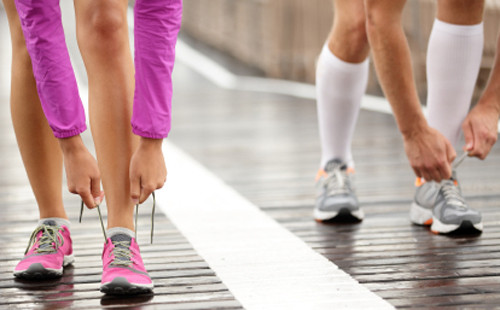Running involves highly repetitive movements and blisters could happen due to friction. Blisters could happen on different parts of our feet, such as between the toes, side of big toe and back of the heel. If our skin is subjected to shearing forces, blisters will likely to form. They are actually a manifestation of our body, defense mechanism. Shearing forces will eventually detach the outer layer of our skin with the inner dermal layer. Fluid will accumulate between these layers and it is intended to provide a cushion against further damaging shearing forces, so our inner dermal layer will be less affected.
In the meantime, our body is preparing to repair the damages by regrowing a new external skin layer. The best method is to prevent blisters from happening. We could significantly minimize shearing forces on our feet by using proper shoes and socks. Unfortunately, if we run fast and long enough, blisters are unavoidable. Small blisters should be painless. They will heal quickly and won’t be infected if left alone. In general, there’s no need to drain blisters by popping them up. The best method of treatment is by reducing friction in the affected area. We should also check our shoes and socks. We need to know how blisters could happen. As an example, we could wear a loose socks, so it crumples and folds inside shoes when we run. Some socks defects and bad stitches could also cause blister to form.
Unfortunately, we need to drain bigger blisters, because our body can’t re-absorb the excess fluid. We will need a sterilized needle and the side of the blister can be punctured. We could use gauze to apply a gentle pressure on the blisters to remove the fluid. After much of the fluid has been drained, we should avoid removing the white, loose skin layer. It is still needed to protect the vulnerable, wet inner dermal layer. The blister should be as dry as possible without removing the skin layer. After each shower, we should pat the blister dry and the moleskin will stay for about 7 days, before it gets dry.
The inner layer of the skin is nearly healed when the corners of the moleskin begin to peel up. However, we need to wait for another 3 days before pulling it off. In fact, it is better if the moleskin is removed on its own. If we tear the moleskin too soon, we will create a new open wound and the healing process will be delayed. The exposed inner dermal will feel slightly painful, especially if it is accidentally touched. If the blisters become red in color and producing pus, we should go to the doctor. We will be given antibiotics to prevent the infections from getting worse. However, it is unlikely for blisters to get infected, if we keep it clean and dry. It is a good idea to sit in the porch so the drained blisters will be exposed to open air.
